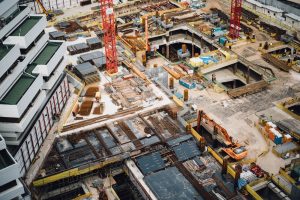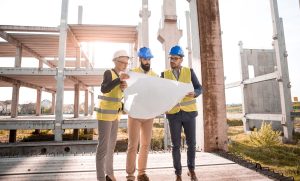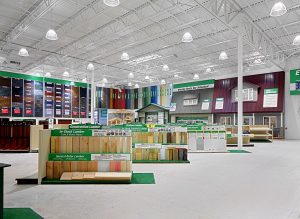Powerful and intelligent technological solutions are rapidly making their way into the construction industry as research and development into sustainable and eco-friendly techniques take shape. Some of these innovative solutions have contributed to the revival of an industry that experienced slow growth in the aftermath of COVID-19 due to labor shortages and supply chain disruptions.
New trends in industrial construction improve efficiency and continue to shape the future of the industry. Below are some of the current trends in industrial construction:
Protective Measures in Construction Sites
The construction industry is seeing revamped safety measures thanks to modern technology. Site safety is a primary concern for supervisors and project managers, and most state regulations have extensively revised safety protocols on site. Currently, there are different machines capable of identifying and flagging safety hazards. These include wearables such as work boots with Wi-Fi connectors that can alert other workers if the wearer is involved in an incident.
Smart headsets that reduce the impact of noises are also making their way to construction sites. Machines, instead of workers, now move heavy and hazardous materials. Environmental sensors that detect wind, heat, and other elements are also being set up at construction sites. These sensors can send out warnings in the event of impending emergencies, facilitating faster evacuation.
Advanced Building Materials
The construction industry is gradually shifting to greener practices and modular technologies. Newer, sustainable materials from 3D printing and other computer-assisted fabrications, such as CNC machining, have replaced older techniques. Living organisms are also incorporated in building and construction to create self-healing surfaces using bacteria.
More start-ups are venturing into construction research to build future infrastructure. The push towards sustainability has also led to the creation and use of bioplastics, mycelium composites, and biofoam, among others. Lighter materials like spider silk and nanomaterials reduce overall load while providing strong frames in large-scale construction. Reinforced materials like aluminium foam and cross-laminated timber are more robust and durable.
Offsite Fabrication
Offsite construction began as a cost-saving measure in mega projects such as the construction of the Burj Khalifa in Dubai. Today, significant developments have been made to make offsite construction more efficient. This has been supported by modular engineering that enables the fabrication of multiple components in the factory.
Offsite construction can complement or replace most of the onsite work. This helps to cut down on on-site waste, saves labor costs and reduces onsite work hours. Offsite construction employs highly adaptable and scalable production methods such as 3D printing and novel assembly. Commercial buildings can use offsite construction for modular and panelized production of walls and other building structures.
Digital Project Management
The use of cloud-based software to plan and manage teams has grown in the construction industry. Industrial construction contractors can use these digital tools to define and outline the steps in each phase of the project. They also help to monitor established KPIs to track progress and ensure safety and compliance. AI tools can determine the feasibility of a project based on pre-defined inputs such as project life, workforce, and budget proposals.
Once the project is deemed feasible, project managers can develop milestones within the digital platform. Contractors can easily share them with team members who have access to the same platform. Digital project management enables real-time collaboration and a continuous feedback loop to keep the project’s main activities on track.
Digital platforms like ERPs enable storing large amounts of data that can be analyzed or referenced at any project stage. As a result, project management enabled by digital infrastructure results in more efficient workflows. It also ensures a clear definition of tasks which is vital for the project completion within specified time frames.
Drones in Construction
The use of drones in the construction industry is one of the fastest-growing trends, with drone construction projects increasing by as much as 239% annually. Drones are used on construction sites for aerial photography and the integration of other tools, such as heat mapping over large areas. Advanced drones provide a steady stream of valuable data, allowing for a better understanding of the project’s trajectory and faster responses to resource allocation and safety concerns.
Drones are used in topographical mapping when planning complex structures. This includes scanning industrial areas and utilizing innovative visualization techniques. For instance, using high-resolution images and creating 3D models helps create an overview of a complex project.
Industrial construction companies use drones for equipment tracking and remote monitoring. They are effective surveillance tools, scanning equipment and personnel, which ensure safety and compliance on the construction site.
Robotics In Construction
Robotics aims to replace manual labor with machines that can process information faster and with greater precision. This can improve construction by getting tasks done faster and more accurately.
Construction is one of the most dangerous and labor-intensive fields. Heavy and hazardous materials, as well as heavy-duty machinery, can cause injuries. Intelligent robots powered by machine vision and AI algorithms can automate heavy machinery reducing safety risks. Construction robots also reduce the chances of errors arising from fatigue or skill gaps in the human labor force.
Robots can also be used for transportation, excavation, and heavy lifting. Robots in construction make construction sites safer for human workers while also increasing productivity, quality, and speed.
Conclusion
The industrial construction industry is literally the building block of the modern economy. Construction of vital infrastructures, such as transport systems and commercial buildings, drives economic activities, so new developments in the construction industry have a widespread impact on other industries.
Trends in industrial construction leverage modern technology to increase effectiveness and use advanced materials, processes, and automation to build better structures that can support future generations. Industrial construction will help to supply much-needed tools for modern sustainable living, such as smart cars, smart devices, and infrastructural components for future smart cities.




